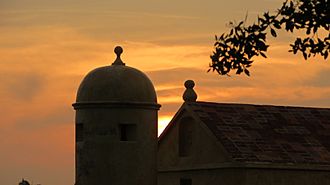San Sebastián del Pastelillo Fort facts for kids
Quick facts for kids San Sebastián del Pastelillo Fort |
|
|---|---|
 |
|
| General information | |
| Town or city | Cartagena de Indias |
| Country | Colombia |
| Coordinates | 10°24′51″N 75°32′37″W / 10.414088°N 75.543736°W |
| Construction started | 1741 |
| Completed | 1744 |
The Fort San Sebastián del Pastelillo is an old military fortress built a long time ago in Cartagena de Indias, Colombia. It was built to protect the city from dangers from the sea.
Contents
History of the Fort
Building the Fort
A leader named Sebastián de Eslava, who was a Viceroy (like a governor for the king), ordered this fort to be built. Work on the fort started in 1741 and finished in 1744. Engineers Juan Bautista Mac-Evan and Carlos Desnaux helped make it happen.
The fort got its name "San Sebastián" from Viceroy Sebastián de Eslava. The "Pastelillo" part means "little cake" in Spanish. People called it this because the fort's shape looked a bit like a cake!
Why the Fort Was Built
The main reason for building this fort was to keep the city safe. It was designed to:
- Stop attacks from pirate ships.
- Prevent people from secretly bringing goods into the city without paying taxes (this is called smuggling).
Later Years and Changes
Many years later, in 1943, the fort was given to the Cartagena Fishing Club. In 1972, an architect named Juan Manuel Zapatero helped fix it up.
In 2021, the Ministry of Culture asked the Fishing Club to make some repairs to the fort. When the club painted the fort's outside walls in August 2021, some people on social media were not happy. They felt that painting an old, important building might change its historical look. This showed how much people care about keeping historical places just as they were.
Fort Structure
The San Sebastián del Pastelillo Fort has three main sections, or "alignments."
- The second section holds 8 cannons. These cannons were used to protect the entrance to Manga Island.
- The third section has 7 cannons. These were used to defend other parts of Manga Island and the path to San Lazaro Hill.
The fort also had a special room to store gunpowder, which was needed for the cannons. There was also a dock where supplies and artillery could be brought in by boat.
See also
 In Spanish: Fuerte de San Sebastián del Pastelillo para niños
In Spanish: Fuerte de San Sebastián del Pastelillo para niños

